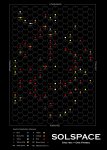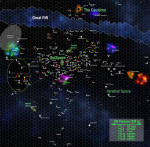Here it is as a download link, it is meant to be near future, realistic star map around Earth (over 100 star systems) all plotted and stat'd out with UPP's -
http://dragonersdomain.com/forum/download/file.php?id=739
It's a work in progress, but it will be my next campaign I run with Classic Traveller/Cepheus Engine or M-Space.
I loved that Buck Rodgers TV program as a kid, and it seems like you have highly detailed your setting, next is probably adventure hooks for it?
I have to say, Wow, that's a lot of work!
My setting is based on the 1970s television show Buck Rogers in the 25th century, but perhaps with a bit less of the "cheese" and the women throwing themselves at Buck Rogers like he some sort of superstar, one thing is true however Princess Ardala, a planetary ruler of Mars in the Sol System did bring Captain Rogers out of Cold sleep, her dad is the Ruler of the Draconian Empire, who's capital is Draconia in the Sigma Draconis system. The Earth is recovering from a nuclear war which happened in the mid-21st century, a nuclear war with the invading forces of Draconia, after the destruction, the Draconian forces decided not to occupy Earth itself, the junk belt created by the war, and the destruction and devastation on the Earth's surface was too much for the Draconians to deal with, so they settled for colonizing Mars instead, and the Draconian princess Ardala was put in charge of it. Ardala had this idea of using Captain Rogers to gain control of Earth itself. the Draconians over the following centuries lost interest in Earth itself, all except Ardala, who is one among many heirs to the throne on Draconia, she is trying to gain the attention of her father by conquering or colonizing Earth itself for the greater glory of Draconia, and so that she may gain suitable favor and become Empress herself when her father dies, she also has a crush on Captain Rogers and wishes to marry him, but he does not return that affection and does not wish to be a political pawn, not to rule as a regent of Earth by the princess's side, he is grateful for the rescue, but has eyes on someone else.
The Earth has a representative government with a leader Director Huer, and Captain Rogers wants no part of Ardala's scheme to overthrow that or conquer it. Ardala does love Captain Rogers, but is a bit forceful and demanding, and is a spoiled princess with a very big ego and a short temper, thus Captain Rogers is a bit eager to stay out of her clutches and has feelings for General Wilma Dearing instead. the General herself is a bit standoffish, and a bit suspicious of Captain Rogers because Princess Ardala was the one that brought him to Earth as part of a diplomatic deception to takeover Earth.
The Capital of Earth is in New Chicago, an Archology built upon the ruins of old Chicago on the shore of Lake Michigan. the Terran forces have begun recolonizing the Solar System, and have taken back the Asteroid Belt and Venus with the Princess still holding on to Mars itself, she feels neglected by her father, but feels that if she asks for too much help, then the Imperial Throne will go to one of her sisters or brothers instead of her, she feels she has to prove she is worthy of the throne and believes that capturing Earth will do it for her.





